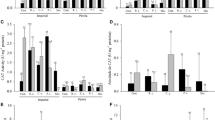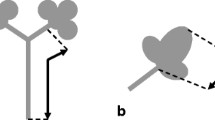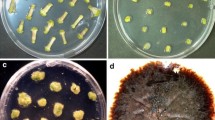Abstract
The aim of the presented work was the search for the relationship between the level of soluble carbohydrates in callus tissues of eight meadow fescue (Festuca pratensis Huds.) cultivars and their growth ability on media containing Bipolaris sorokiniana and Drechslera dictyoides metabolites. Calli were induced from mature grains using the method previously described (Płażek 1994). Callus obtained from single caryopsis was cut into three pieces which were weighted and put on the media with or without pathogen metabolites. Tissue selection was performed by means of “double-layer culture” technique (Lepoivre et al. 1986). After two-week culture in the darkness at temp. of 25°C the calli were weighted again. The sugar level in tissue was measured by means of colorimetric method of Klein & Weissman according to Snell (1961).
Fresh mass decrease of calli developing on the media with fungus metabolites was observed by all studied object. The tolerance of calli of the tested cultivars to metabolites of both pathogens was significantly different. However, significant similarity between the tolerance of calli of particular varietes to both fungi was noted.
The soluble carbohydrate contents in control tissue of all studied cultivars were similar and their values ranged between 2.4 and 3 % of fresh mass. B. sorokiniana metabolites caused a significant decrease of the sugar content in calli, while D. dictyoides metabolites did not decrease the sugar level.
Similar content being viewed by others
References
Chawla H.S., Wenzel G. 1987. In vitro selection of barley and wheat for resistance against Helminthosporium sativum. Theor. Appl. Genet. 74: 841–845.
Czaplińska S., Bielecki K., Grzyś E., Skrabka H., Szuwalska Z. 1983. The resistance of maize to Fusarium sp. in dependence of sugar concentration in stem. Part I. The changes of sugar content in maize stem during vegetative season and disease degree by infection with fungi of Fusarium sp. Hod. Rośl. Aklim. Nas. 27: 193–205 (In Polish).
Durbin R.D. 1981. Toxins in plant disease. Academic Press, New York-London-Toronto-Sydney-San Francisco.
Farrar J.F. 1989. Fluxes and turnover of sucrose and fructans in healthy and diseased plants. J. Plant Physiol. 134: 137–140.
Jakubowski S., Stuczyńska J. 1982. Some analytical aspects by estimation of carbohydrate contents in plant material. Biul. IHAR 147: 3–11 (In Polish).
Lepoivre P., Viseur J., Duhem K., Carels N. 1986. Double layer technique as a tool for the selection of calluses resistant to toxic material from plant pathogenic fungi. J. Semal (Ed) “Somaclonal variation and crop improvement”, Martinus Nijhoff Publ.: 45–53.
Milczak M., Piotrowski J., Segit Z. 1985. The changes in chemical content in some hop forms in dependence of sensitivity degree to Verticillium albo-atrum and Fusarium sambucinum. Part II. The content of amino acids, soluble sugars and peroxidase activity. Biul. IHAR 158: 109–115 (In Polish).
Murashige T; Skoog F. 1962. A revised medium for rapid growth and bioassays with tobacco tissue cultures. Physiol. Plant. 15: 4473–497.
Nelson C.J., Spollen W.G. 1987. Fructans. Physiol. Plant. 71: 512–516.
Płażek A. 1994. In vitro selection of Festuca pratensis (Huds.) callus on the metabolites of Drechslera sp. pathogens. Proceedings of the 19th Fodder Crop Section Meeting held in Brugge, Belgium, 5–8 October 1994: 183–184.
Płażek A. 1996. The influence of sugar concentration in a medium on the development of chosen fungi of Bipolaris and Drechslera genera. Biul. IHAR 199: 171–178. (In Polish)
Rines H.W., Luke H.H. 1985. Selection and regeneration of toxin-insensitive plants from tissue cultures of oats (Avena sativa) susceptible to Helminthosporium victoriae. Theor. Appl. Genet. 71: 16–21.
Rodricks J.V., Hesseltine C.W., Mehlman M.A. 1977. Mycotoxins in human and animal health. Pathotox Publishers, Inc., Park Forest South, Illinois.
Rubin B., Arcichowska J. 1971. Biochemistry and physiology of plant resistance. PWRiL Warszawa (In Polish).
Shotwell O.L., Ellis J.J. 1976. Helminthosporium, Drechslera and Bipolaris toxins. 318–343 In: Mycotoxins and other fungal related food problems. J. V. Rodricks (red.), Advances in chemistry, Ser. 149, Am. Chem. Soc.
Skrabka H., Przybyłka E. 1983. The resistance of maize to Fusarium sp. in dependence of sugar concentration in stem. Part II. The quantitative analysis. Hod. Rośl. Aklim. Nas. 27: 207–211 (In Polish).
Snell F.D. 1961. Colorimetric methods of analysis. III, A. Ed. Van Nostrand Company.
Streuter N., Moerschbacher B.M., Fischer Y., Noll U., Reisener H.J. 1989. Fructose-2,6-bisphosphate in wheat leaves infected with stem rust. J. Plant Physiol. 134: 254–257.
Zabotina O.A., Gurjanov O.P., Ayupova D.A., Beldman G., Voragen A.G.J., Lozovaya V.V. 1996. Biologically-active soluble oligosaccharides from pea stem tissues. Plant Cell Reports 15: 954–957.
Author information
Authors and Affiliations
Rights and permissions
About this article
Cite this article
Płażek, A. Relationship between soluble carbohydrate level and tolerance of meadow fescue callus to Bipolaris sorokiniana (Sacc.) Shoem. and Drechslera dictyoides (Drechsl.) Shoem. metabolites. Acta Physiol Plant 20, 347–351 (1998). https://doi.org/10.1007/s11738-998-0018-0
Received:
Accepted:
Issue Date:
DOI: https://doi.org/10.1007/s11738-998-0018-0




